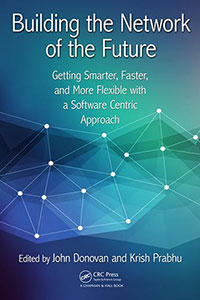We believe the network of the future will be about the entire connected experience, not just faster speeds.
We call this new platform AT&T Network 3.0 Indigo (Indigo). It’s a software-defined and data-powered network that also includes blazing fast internet speeds.
Yesterday's hardware-intensive network won't work in the path to 5G. Some 137 petabytes of data traffic cross our network on an average business day. Data traffic on our mobile network has increased more than 250,000% since 2007.
Video now makes up more than half of our mobile data traffic. In fact, video traffic grew over 75% and smartphones drove almost 75% of our data traffic in the last year alone. We'll stay ahead of this demand with a combination of speed, software and data.
We're in Barcelona today at the Mobile World Congress (MWC) trade show sharing these insights with the industry. But we want to highlight them here, too. These three capabilities will have a major impact on the mobile experience for everyone:
5G Evolution
Showcase of 5G Evolution Speeds: At MWC, along with Qualcomm Technologies, Inc. and Ericsson, we’re showing how users can reach ultra-fast speeds by using technologies like carrier aggregation, 4x4 MIMO, 256 QAM and LTE-License Assisted Access (LAA). We’ve also announced plans to launch our first 5G Evolution markets in Indianapolis and Austin in the coming months. We expect our wireless network in those cities to initially offer theoretical peak speeds of 400Mbps or higher.1 As we continue densifying our network and deploying technologies like carrier aggregation and LTE-License Assisted Access (LAA), we expect to enable theoretical peak speeds up to 1Gbps in some areas in 2017.
5G trial updates: In 2016, we launched the industry’s first 5G fixed wireless business customer trial in Austin. In 2017, we will expand our activities and trials providing new, innovative mobile-first video services.
This spring, we'll kick-off a second trial in Austin with Ericsson's 5G RAN and the Intel® 5G Mobile Trial Platform. Residential and small-to-medium business customers will be able to stream DIRECTV NOW and access next-gen entertainment and enhanced broadband services. The trial will also benefit from the resources and capabilities of our 2 new 5G testbeds in Austin.
At these testbeds, we'll work on advanced 5G technology concepts for fixed and mobile solutions. We'll also explore 5G coverage for the 28GHz, 39GHz, and sub-6GHz frequency bands.
Earlier this month with Nokia, we reached a critical milestone. We delivered DIRECTV NOW over a fixed wireless 5G connection using 39 GHz millimeter wave (mmWave) technology at our Middletown, New Jersey lab. This is a world’s first using 39 GHz spectrum. We anticipate it will play a key role in 5G.
We're also enabling the 5G ecosystem with both Intel and Qualcomm Technologies device platforms to quickly test and build towards 3GPP New Radio (NR) interoperability. This lays the foundation for early access to Intel's 5G modem roadmap. And it advances our understanding of various spectrum bands, including 39 GHz.
Global standards collaboration: We’re collaborating with over a dozen global technology companies to prioritize important specifications in the standards to bring 5G to market as quickly as possible.
Our standards team found we're the top North American wireless carrier contributor into 3GPP's work on 5G standards since the start of 2016. Our impact not just based on the number of our contributions, but also on the progress we've made in standards development.
This includes the ability of 5G to co-exist on the same spectrum as LTE, an energy- and battery-efficient physical layer and a framework for massive MIMO. We've made multiple material contributions to standards for all radio access network layers. This includes the physical, protocol and systems architecture layers, as well as the system requirements, architecture, security and performance aspects of 5G.
Drones: We recently had our first successful test flight of what we call a “Flying COW.” This stands for Cell on Wings. We started this project in our AT&T Foundry and it’s now part of our Technology & Operations drone program. It could eventually provide emergency network coverage in disaster areas or at concerts or sports events. It’s yet another element to our connectivity strategy.
Augmented & virtual reality: Check out our blog post from earlier today about how AT&T Foundry is exploring the capabilities of AR/VR over 5G and 5G Evolution.
The key is we're being aggressive when it comes to preparing for a 5G world. But we also know that going it alone is a risky move for us and our customers.
We've seen in the past companies that race to be first with proprietary technology end up in a dead end and have to backtrack. Worse, customers get stuck with potentially obsolete phones and other gear. We intend to be aggressive and smart.
Our Indigo network is the result of years of planning not just around access technologies like 5G and 5G Evolution. It's also the result of our work in areas like software defined networking and data analytics.
SDN
ECOMP: The Linux Foundation announced that OPEN-O will join ECOMP to create ONAP. Alignment of the 2 projects creates a harmonized and comprehensive framework for real-time, policy-driven software automation of virtual network functions. This will let software, network, IT and cloud providers and developers quickly create new services. We’re thrilled to see membership in ONAP growing as it becomes the standard “operating system” for software-defined networks. In fact, at its inception, ONAP carriers serve up to an estimated 40% of global mobile subscribers.
AT&T Integrated Cloud: We beat our 30% virtualization goal for 2016, reaching 34%. Our 2017 goal is 55%. To meet that, we’ll continue to build out and upgrade what we call the AT&T Integrated Cloud, or AIC. AIC zones are the physical locations around the world where we run virtual network functions. AIC is how we’re bringing the network to the cloud.
We have more than 80 AIC zones now, and we plan to have over 100 by the end of the year. The AIC runs on the open source software OpenStack. We continue to work closely with that community to refine this platform.
Building the Network of the Future: Our experts are literally writing the book on the network of the future. And if you don’t believe me, check out the accompanying image to this blog.
Data Analytics
Data communities: All these projects will help facilitate “data communities” on Indigo. It’s our major push to create a trusted environment where organizations can share data and collaborate on analytics. You can read an overview here and download a technical paper here.
25G Evolution peak theoretical wireless speeds will be enabled in select market areas and require a compatible device.


Andre Fuetsch - President , AT&T Labs and Chief Technology Officer